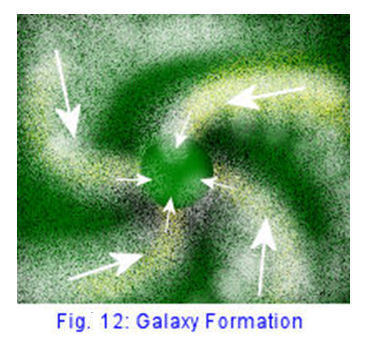|
C-3 Heavy

I make an important distinction between two forms of Dark Matter resulting from Critical Event Three (C-3). One is C-3 Dark, consisting of random go-dot or gravitation platelets that spread with relative uniformity across empty space within the cosmos (inside the limit of the cosmopause that can be mathematically projected as a theoretical sphere, analogous to the heliopause in our solar system). The other is C-3 Heavy.
C-3 Heavy is a subset of the more general C-3 Dark. The difference is that the specific subset C-3 Heavy will be found as black hole material (which is C-3 Dark stuff resulting from the C-3 critical event or 'big bang' moment.
Of the Dark Matter ejected from the C-3 point (Big Bang), significant amounts will remain stuck together by their natural platelet gravitational attraction. Remember, these are neither particles nor energy waves, but pure primordial 'Third Thing' somethings I have dubbed go-dots. Because they are neither matter nor energy in commonly measured forms (but 'Third Thing' go-dot gravitation platelets), I see the following divisions of 'stuff' in our universe through a somewhat different lens. This does not destroy the Standard Model but (I think) sharpens it. Fundamental thing to realize: our terminology is driven by our observational history, like the old Ptolemaic cycles and epi-cycles. Inherent in all or most existing models is the simple distinction between 'visible' and 'not visible.' Basically, 5% of the stuff in our universe is 'visible' (detectable by eye or telescope or the like) while 95% is 'invisible,' as noticed initially in the orbital dynamics of observed galaxies: namely, that the amount visible as starlight and light waves could not contain sufficient gravitational mass to hold the galaxy together at the velocity at which it is rotating around its central core (which we now know typically is a super-gravitational locus or 'black hole').
The Standard Model (Wikipedia Quick Lookup) breaks down the three outcomes very similarly: "Dark matter constitutes about 26.5% of the mass-energy density of the universe. The remaining 4.9% comprises all ordinary matter observed as atoms, chemical elements, gas and plasma, the stuff of which visible planets, stars and galaxies are made. The great majority of ordinary matter in the universe is unseen, since visible stars and gas inside galaxies and clusters account for less than 10% of the ordinary matter contribution to the mass-energy density of the universe." (sources at Wikipedia article). I don't know to what extent my C-3 Dark and C-3 Heavy (both 'dark matter') might be analogous (or not) with such existing theories as 'cold dark matter' and 'hot dark matter.'
We can agree on the (rounding) 5% visible matter (C-3 Bright). A divergence comes in that there is no so-called Dark Energy (black box terminology) in the Exogravitation Model. Rather, the inclusive super-set Dark 95% consist of the core C-3 Dark scattered through our local cosmos *including* the subset C-3 Dark (Heavy) that concentrates into black holes. By the dynamics of the early universe immediately after C-3 (Big Bang event or moment) and the resulting outward rush of material in a turbulent chaos resolved into logically gravitation-induced gyres, the result is galaxy formation. While there are various structures in the cosmos, there appears to be a commonality of rotating disk-shaped galaxies, often with so-called arms or spokes wheeling in balance around that central black hole core.
These vast blobs of go-dots remain stuck together and go spinning away from the C-3 (Big Bang) point in all directions. As they fly out (after the initial 300MY condensate phase identified by scientists for the early universe) their enormous dark mass gathers C-3 Bright material to form what we call galaxies ('milks'… talk about nomenclature!).




NOW AVAILABLE: The book (article) by John T. Cullen is now available for purchase at Amazon.com and other sites or stores. Visit:
|
E-Book
|
P-Book
|
Browse or Buy at Amazon
The book linked at left is an e-book edition to browse; or buy & download from Amazon for your Kindle reader.
The middle link is for the corresponding print edition. This short book is a standard 6x9" trim size. More info at Amazon.com.
Most print editions are also available at Barnes & Noble online; or call/visit your local bookstore to order.
|
TOP
|